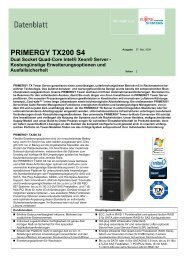GA-EX58-UD3R - Hardware
GA-EX58-UD3R - Hardware
GA-EX58-UD3R - Hardware
You also want an ePaper? Increase the reach of your titles
YUMPU automatically turns print PDFs into web optimized ePapers that Google loves.
Chapter 2<br />
BIOS Setup<br />
BIOS (Basic Input and Output System) records hardware parameters of the system in the CMOS on the<br />
motherboard. Its major functions include conducting the Power-On Self-Test (POST) during system<br />
startup, saving system parameters and loading operating system, etc. BIOS includes a BIOS Setup<br />
program that allows the user to modify basic system configuration settings or to activate certain system<br />
features. When the power is turned off, the battery on the motherboard supplies the necessary power<br />
to the CMOS to keep the configuration values in the CMOS.<br />
To access the BIOS Setup program, press the key during the POST when the power is turned<br />
on. To see more advanced BIOS Setup menu options, you can press + in the main menu<br />
of the BIOS Setup program.<br />
To upgrade the BIOS, use either the GI<strong>GA</strong>BYTE Q-Flash or @BIOS utility.<br />
• Q-Flash allows the user to quickly and easily upgrade or back up BIOS without entering the<br />
operating system.<br />
• @BIOS is a Windows-based utility that searches and downloads the latest version of BIOS from the<br />
Internet and updates the BIOS.<br />
For instructions on using the Q-Flash and @BIOS utilities, refer to Chapter 4, "BIOS Update Utilities."<br />
• Because BIOS flashing is potentially risky, if you do not encounter problems using the<br />
current version of BIOS, it is recommended that you not flash the BIOS. To flash the BIOS,<br />
do it with caution. Inadequate BIOS flashing may result in system malfunction.<br />
• BIOS will emit a beep code during the POST. Refer to Chapter 5, "Troubleshooting," for the<br />
beep codes description.<br />
• It is recommended that you not alter the default settings (unless you need to) to prevent<br />
system instability or other unexpected results. Inadequately altering the settings may result<br />
in system's failure to boot. If this occurs, try to clear the CMOS values and reset the board<br />
to default values. (Refer to the "Load Optimized Defaults" section in this chapter or introductions<br />
of the battery/clearing CMOS jumper in Chapter 1 for how to clear the CMOS values.)<br />
- 33 - BIOS Setup















